How To Find Red Wiggler Worms In Your Yard
How To Raise Worms
Why heighten earthworms?
Raising earthworms is one of the easiest ways y'all tin can go green and reduce the amount of trash entering our landfills and water systems. Instead of throwing your kitchen scraps in the garbage tin can or down the sink disposal just feed them to your worms! And if you bask gardening this is a bully fashion to save money -- your worms volition produce fertilizer for life! Earthworms can produce more compost, in a shorter time, with less effort, than whatever other tool known to the gardener or farmer. The compost which is produced past earthworms is of the highest class, containing not merely greater amounts of mineral nutrients in soluble grade, but besides containing a high percentage of castings that help to form soil aggregates, leading to a permanent improvement in soil structure. Are you a fisherman, too? Why pay $4.00 for a dozen worms when you can raise them yourself? Whatever your reason for raising earthworms, y'all will enjoy watching your critters grow, reproduce and recycle!
A good for you cherry wiggler bin
Which types of earthworms are used for composting?
In that location are iii types of composting worms and ane type of garden worm available here at Worms4Earth.com, I will list the three types of composting worms in this section. You tin can read about the garden worms further downwardly the page.
The Reddish Wiggler
Red wigglers stand out equally the best selection for efficiently composting your kitchen scraps and paper waste. They have a voracious appetite, thrive in a densely populated surface area, and are tolerant of a broad range of ecology weather condition. They are non hands disturbed by the turning and raking of bedding that is necessary when calculation food scraps or checking the progress of decomposition in your earthworm bin. These qualities translate into the perfect species for the earthworm farming beginner. The Carmine wiggler is identified by its deep red coloring, sparse banding, and xanthous-tipped tail-end. Their diminutive size makes them ideal for smaller habitats, yet this should not diminish the fact that Cherry-red wigglers are also very successful working in large scale composting operations. These earthworms form no permanent burrows and live on the soil surface and uppermost layers of your compost bin. They feed in organic surface debris and are well adapted to rapidly changing weather condition of a compost bin. Although this hardy worm will survive temperatures close to xl°F, they adopt bedding temperatures betwixt 68°F and 80°F. The Red Wiggler grows to a length of 3-4 inches, but don't let it'southward diminutive size fool you lot - these little guys process large amounts of organic material. You'll exist able to compost your kitchen scraps 10 times faster when compared to composting without them.
These bed run worms are shipped in breathable bags and will come in various sizes, from juvenile to breeder. There are between 800 - one,000 worms per pound.
Add Cherry-red Wigglers to your indoor compost bin or outdoor compost pile..
A typical carmine wiggler bin
Freshwater aquarium fish dear Cerise Wigglers
The European Nightcrawler
The European nightcrawler is a superb option to use for angling bait. They grow relatively quickly, are less sensitive to cold weather, and stay firm on the hook. Do yous take memories of using a Canadian nightcrawler that went limp and soggy on your hook after a simply few minutes? The European will stay alive while submerged for much longer than other earthworms. And, although it does non grow as long as the African nightcrawlers, it has enough of width to fit on larger hooks when fishing for bass or catfish.
The European nightcrawler is also tops in the worm casting business. Raised extensively in Holland, it has been exported around the earth and has become a favorite within the earthworm casting manufacture because of its tolerance to a wider range of temperatures. It can exist identified by its very distinctive striped banding and wide girth. Although smaller in total size than the African nightcrawler, the quality of its castings are not afflicted by the size difference. You tin feed them either kitchen scraps or grain repast. The European nightcrawler is more tolerant of lower temperatures than the Africans; yet, they volition still perish if exposed to freezing temperatures
The European Nightcrawler can grow upwards to 5 inches and is THE BEST BAIT WORM available. Its thick peel gives information technology the power to live longer on the hook than whatever worm sold today (fifty-fifty in stagnant and saltwater).
Add together Europeans to your indoor compost bin or outdoor compost pile.
European nightcrawlers from a bin
The African Nightcrawler
The African nightcrawlers, one of the kings of the earthworm castings industry, are known for the large quantities of castings they tin produce in a short corporeality of time. It can be identified by its chocolate-brown-majestic coloring with a light-green irised sheen. This earthworm is the largest composting earthworm on the market and can abound over 7 inches in length. You lot tin feed them either kitchen scraps or grain meal. However, there are a few drawbacks that you must consider if you lot choose the African nightcrawler. This earthworm is a tropical species and has evolved to alive in warmer climates; its environmental necessity for temperatures over 65°F may dictate the demand to be raised indoors where temperatures tin can be controlled. The other drawback is that, due to their size, they will require more frequent bedding changes. The African nightcrawler consumes feed and produces castings quickly which will crave y'all to add together fresh bedding more ofttimes when housed in smaller habitats.
The African nightcrawler should exist your earthworm of option when large size is what you desire. Even so, it is imperative that you have the power to go along their habitat at a controlled temperature between 65°F and 85°F such as a basement, spare room, or temperature controlled garage. Water survivability is by and large good except for very cold waters such equally spring-fed rivers and streams and northern waters.
When raising earthworms for fishing bait I recommend feeding them milled grains specifically formulated for feeding earthworms. Check with your local feed shop; if they do not bear in stock they should be able to order it for you lot.
The African Nightcrawlers are shipped 3-4 inches long and are breeder size. In that location are approximately 250 worms per pound.
Add together African Nightcrawlers to your indoor compost bin or outdoor compost pile.
African nightcrawlers size comparing
Which type of earthworms for my garden?
The Alabama Jumper
You can add the Alabama jumper direct into your chiliad or garden. Alabama Jumpers can thrive in just near whatever kind of soil, including packed dirt, and will aerate and fertilize your chiliad and garden. These worms are very active and can burrow through the thickest soils with ease. They have thick peel and are very powerful -- true to their proper name, they will literally jump out of your hand.
Alabama Jumpers jumping
Alabama Jumpers, like other earthworms, have but three basic life requirements: food, water, and protection from harmful agents. Of the three, it is probably the lack of sufficient nutrient is what retards the earthworms population in most gardens and croplands.
Assuming that soil factors are favorable, an Alabama Jumper population volition grow only insofar as additional organic thing is incorporated into the soil. This may come up in the form of compost, manure, decomposable plants, or organic wastes of a wide diverseness. It may be added to the soil and tilled in, or grown in the soil so plowed under. Any way it is added, organic matter is essential to encouraging greater numbers of earthworms in the soil. In addition once an earthworm population has been increased, plenty organic matter must be supplied periodically in gild to maintain that increase.
Ensure that you have plenty of leaves, hay, or any organic material in place before adding these worms and then that these critters have a skillful food supply. Ensure your soil is moist then add worms right earlier the sun goes down. Distrubute your worms evenly and embrace with soil.
Calculation Alabama Jumpers to soil
Where can I enhance worms?
Earthworms need only a few requirements in which to successfully alive and breed. These requirements are moisture, darkness, and nutrient. These conditions can be found in whatsoever outdoor compost pile, which is definitely the easiest type of worm organisation to maintain. But, because these requirements are and so easily produced, many people choose to build a bin they can keep indoors, which besides has its advantages.
Worm Bins
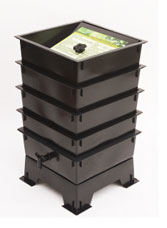 Many people who are new to raising earthworms begin raising them in a Practise-It-Yourself plastic storage bin or a manufactured worm bin organisation. The convenience of portability along with the fact that most folks volition not be raising populations in the tens of thousands makes the indoor worm bin system an easy project. And for those
Many people who are new to raising earthworms begin raising them in a Practise-It-Yourself plastic storage bin or a manufactured worm bin organisation. The convenience of portability along with the fact that most folks volition not be raising populations in the tens of thousands makes the indoor worm bin system an easy project. And for those  who are contemplating raising worms on a big calibration, the worm bin is a smart way to acquire how to raise them in a controlled environment before making a big investment. Considering the extremes of heat and common cold climates tin be harmful to earthworms, raising them indoors ensures that their environment will always be climate controlled. You can put the bin in your garage (if cool), basement, closet, spare chamber or your porch. If you lot make up one's mind to keep your bin outside, keep it abroad from directly sunlight. For those of you living in the southward, putting your bin outside may exist too hot during the summer months -- the combination of heat and humidity definitely becomes a factor when raising earthworms in a plastic bin that isn't designed to insulate confronting that kind of conditions.
who are contemplating raising worms on a big calibration, the worm bin is a smart way to acquire how to raise them in a controlled environment before making a big investment. Considering the extremes of heat and common cold climates tin be harmful to earthworms, raising them indoors ensures that their environment will always be climate controlled. You can put the bin in your garage (if cool), basement, closet, spare chamber or your porch. If you lot make up one's mind to keep your bin outside, keep it abroad from directly sunlight. For those of you living in the southward, putting your bin outside may exist too hot during the summer months -- the combination of heat and humidity definitely becomes a factor when raising earthworms in a plastic bin that isn't designed to insulate confronting that kind of conditions.
Check out the Go Started web page to larn how to build your own practise-it-yourself bin. If you don't desire to build your own, I also offer an splendid production made from recycled plastic correct here in the U.s.a.A. It is called the Worm Factory Worm Bin and information technology is an upward migration, multi-tiered organization. For more than info, bank check out the Worm Factory Worm Bin web page.
![]() If you decide to keep your worm bin in the garage go along in mind that worms will broil in a airtight garage with no air conditioning. I tin can tell you from personal experience that earthworms will not do well in a plastic storage container sitting in a hot garage with temperatures exceeding 100° F in the middle of the summer. Plastic bins are not insulated and then the hot ambience air temperature will easily transfer to the contents of your bin. If you don't have a basement, keep them in a utility or spare bedroom.
If you decide to keep your worm bin in the garage go along in mind that worms will broil in a airtight garage with no air conditioning. I tin can tell you from personal experience that earthworms will not do well in a plastic storage container sitting in a hot garage with temperatures exceeding 100° F in the middle of the summer. Plastic bins are not insulated and then the hot ambience air temperature will easily transfer to the contents of your bin. If you don't have a basement, keep them in a utility or spare bedroom.
Compost Pile
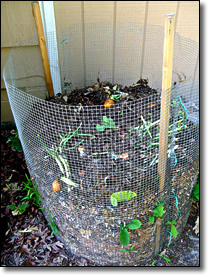 Hey all of you lot gardeners out there -- did you know that earthworms are the most efficient composters in nature? Your pile will be composted ten times faster with earthworms than without them. I of the advantages of a maintaining a garden compost pile is that the finished vermicompost is conveniently close to your fruits and vegetables. Making a compost pile is easy -- simply get yourself some chicken wire and make a simple enclosure (this is optional), find a overnice shady spot, rake up some dead leafage or grass mulch and add some kitchen scraps. Water thoroughly and add together earthworms in a week or ii. You tin add any of the three types of composting worms listed above to your compost pile. Yous'll even find that your compost pile volition begin to attract a lot of the native species of worms you lot have in your one thousand (this merely applies to areas that have native species -- some places may not have earthworms such equally New Mexico and Arizona). To add them to your pile just dig a hole in the top of your pile, place your worms in the pigsty, and cover them up. You'll desire to go along your pile watered, merely not soggy every bit this could make you pile heat upward too fast.
Hey all of you lot gardeners out there -- did you know that earthworms are the most efficient composters in nature? Your pile will be composted ten times faster with earthworms than without them. I of the advantages of a maintaining a garden compost pile is that the finished vermicompost is conveniently close to your fruits and vegetables. Making a compost pile is easy -- simply get yourself some chicken wire and make a simple enclosure (this is optional), find a overnice shady spot, rake up some dead leafage or grass mulch and add some kitchen scraps. Water thoroughly and add together earthworms in a week or ii. You tin add any of the three types of composting worms listed above to your compost pile. Yous'll even find that your compost pile volition begin to attract a lot of the native species of worms you lot have in your one thousand (this merely applies to areas that have native species -- some places may not have earthworms such equally New Mexico and Arizona). To add them to your pile just dig a hole in the top of your pile, place your worms in the pigsty, and cover them up. You'll desire to go along your pile watered, merely not soggy every bit this could make you pile heat upward too fast.
![]() When you lot turn your pile employ a pitch fork if you lot have ane. You will e'er run the risk of injuring or killing a few worms when you turn your pile, merely a pitch fork is less intrusive than a shovel and will continue your losses to a minimum.
When you lot turn your pile employ a pitch fork if you lot have ane. You will e'er run the risk of injuring or killing a few worms when you turn your pile, merely a pitch fork is less intrusive than a shovel and will continue your losses to a minimum.
What size bin do I use?
You volition want a bin that gives plenty space to house your worms and bedding. For do-it-yourselfers, an xviii gallon (give or accept two gallons) bin is a good size to start with. Starting with three pounds of worms gives y'all a expert amount to procedure your kitchen scraps. This corporeality also allows plenty room for your earthworms to reproduce every bit your worm bin can concur upwards to effectually 9 pounds of worms.
Use only opaque bins. Run across-through bins volition stress your earthworms every bit they will continually dig toward the center of your bin trying to go away from calorie-free.
If you choose to get with a Worm Factory y'all will need to assess how many trays and how many pounds of worms you want to brainstorm with. If you have whatsoever questions delight to non hesitate to contact Worms4Earth!
What kind of bedding do I use for my bins?
There are several types of bedding that you tin employ. I'll outline the most popular types and list some pros and cons of each blazon.
Shredded Paper
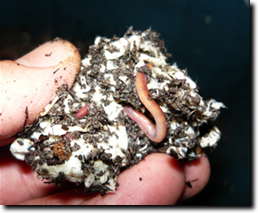 A readily bachelor source of bedding is newspaper. You will need to shred the paper before putting information technology in your bin. You tin can mitt shred it or use machine shredded paper. In my opinion, though, hand shredding is improve as it doesn't clump or get matted together. If you cull to hand shred your paper make certain the strips are no greater that ii-iii inches wide. You volition besides demand to moisten the paper before adding it to your bin. You tin can mist information technology with a spray bottle or soak it and wring out so it isn't soggy. Ane of the advantages of paper is that worms tin survive in information technology without adding whatever kitchen scraps. Merely, although they won't starve to death eating just paper, a paper-but nutrition will produce very modest worms.
A readily bachelor source of bedding is newspaper. You will need to shred the paper before putting information technology in your bin. You tin can mitt shred it or use machine shredded paper. In my opinion, though, hand shredding is improve as it doesn't clump or get matted together. If you cull to hand shred your paper make certain the strips are no greater that ii-iii inches wide. You volition besides demand to moisten the paper before adding it to your bin. You tin can mist information technology with a spray bottle or soak it and wring out so it isn't soggy. Ane of the advantages of paper is that worms tin survive in information technology without adding whatever kitchen scraps. Merely, although they won't starve to death eating just paper, a paper-but nutrition will produce very modest worms.
Pros: Readily available, clean, no grit, odorless, easily prepared (if auto shredded).
Cons: Tends to matte, making information technology difficult to bury waste, preparation time (if hand shredded).
Peat or Sphagnum Moss
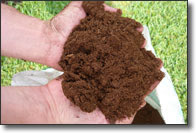 This has long been the composter's choice for raising earthworms. Information technology has excellent moisture retentiveness and is readily available from your local garden or dwelling improvement store. You volition demand to moisten the peat earlier adding to your bin. Soak until completely saturated, and so clasp until just damp like a sponge. And... although worms will consume peat, you must add other food such as kitchen scraps or paper because peat has no nutritive value.
This has long been the composter's choice for raising earthworms. Information technology has excellent moisture retentiveness and is readily available from your local garden or dwelling improvement store. You volition demand to moisten the peat earlier adding to your bin. Soak until completely saturated, and so clasp until just damp like a sponge. And... although worms will consume peat, you must add other food such as kitchen scraps or paper because peat has no nutritive value.
Pros: Readily available, retains moisture.
Cons: Recognized as being environmentally unsustainable, tin can be acidic.
![]() Because peat tin to be slightly acidic, I recommend soaking your peat for 24 hours before putting in your worm bin OR adding a cup of lime to the water if you don't want to soak for that long (the calcium in the lime raises the pH). Y'all can besides add a 1-2 teaspoons of lime to the kitchen scraps each fourth dimension you add together nutrient to your bin. Crushed eggshells will also raise the pH.
Because peat tin to be slightly acidic, I recommend soaking your peat for 24 hours before putting in your worm bin OR adding a cup of lime to the water if you don't want to soak for that long (the calcium in the lime raises the pH). Y'all can besides add a 1-2 teaspoons of lime to the kitchen scraps each fourth dimension you add together nutrient to your bin. Crushed eggshells will also raise the pH.
![]() If y'all cull to add lime to your bin, make certain y'all don't purchase slaked/hydrated lime. Slaked and hydrated are toxic and will fire your earthworms. Slaked/hydrated lime is used in making mortar and cement.
If y'all cull to add lime to your bin, make certain y'all don't purchase slaked/hydrated lime. Slaked and hydrated are toxic and will fire your earthworms. Slaked/hydrated lime is used in making mortar and cement.
Manure
Manure tin exist used as either bedding or food and is generally used for outdoor worm beds and compost piles. You lot tin can use rabbit manure, composted cow or horse manure to elevation off your bin if you utilise peat as bedding. Rabbit manure is particularly bonny for worm farmers because it is a "cold" manure -- it does not need to sit for weeks composting before calculation to your worm bin. The manure already contains loads of microorganisms that earthworms thrive on. Earthworms LOVE manure and thrive on the nutrients available within it. Manure is a natural habitat for composting worms and contain many of the organisms vital to an earthworm'south growth.
Pros: Highly nutritional, often costless when obtained from local stables or farms.
Cons: Fresh cow and horse manure volition heat up when fresh and needs to compost several weeks before use. May contain de-worming drugs.
![]() There is one potential downside to using horse and cow manure; if the animals were given de-worming drugs this could be fatal to your worms. Any amount of de-worming drug the animal'southward body did not absorb will exist present in their stool. A adept rule of thumb is to just use composted manure that is at least two months old.
There is one potential downside to using horse and cow manure; if the animals were given de-worming drugs this could be fatal to your worms. Any amount of de-worming drug the animal'southward body did not absorb will exist present in their stool. A adept rule of thumb is to just use composted manure that is at least two months old.
Coconut Coir
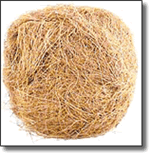 Kokosnoot fiber, or coir, is a renewable fabric that comes primarily from India and Sri Lanka. Information technology is becoming more popular with organic composters as well as the hydroponic growing industry. It may exist a bit pricier that some other bedding cloth, merely you lot will be satisfied to know that y'all are using a renewable of bedding when compared to peat moss. Merely, merely like peat, your worms cannot survive in kokosnoot fiber alone.
Kokosnoot fiber, or coir, is a renewable fabric that comes primarily from India and Sri Lanka. Information technology is becoming more popular with organic composters as well as the hydroponic growing industry. It may exist a bit pricier that some other bedding cloth, merely you lot will be satisfied to know that y'all are using a renewable of bedding when compared to peat moss. Merely, merely like peat, your worms cannot survive in kokosnoot fiber alone.
Pros: Make clean, odorless, mixes well with other bedding, retains moisture well, renewable source.
Cons: More expensive than other bedding textile, more than difficult to obtain.
![]() It is always a proficient idea to "plow" or "fluff" your bedding at least once a calendar week. You lot tin do this by digging downwards to the bottom and bringing the bedding to the tiptop. This ensures that plenty of air is in contact with the contents of your bin. You desire your bedding to have plenty of oxygen so decomposition remains accelerated, plus it makes it easier for your worms to clamber through it.
It is always a proficient idea to "plow" or "fluff" your bedding at least once a calendar week. You lot tin do this by digging downwards to the bottom and bringing the bedding to the tiptop. This ensures that plenty of air is in contact with the contents of your bin. You desire your bedding to have plenty of oxygen so decomposition remains accelerated, plus it makes it easier for your worms to clamber through it.
Feeding - What, How, and How Much?
What do I feed earthworms?
The earthworm is an eating auto. It literally eats the globe equally it burrows through it. Material that is likewise large to ingest will exist pushed aside with its "head" (prostomium). Worms don't take teeth, and then the material they consume is starting time moistened in their mouth so passed into their gizzard which acts like teeth and grinds the food. The nutrient is then passed to their intestines which absorb the nutrients contained within. Any the worm doesn't digest is then passed out of their bodies as nitrogen rich worm castings.
![]() An important fact to know almost feeding your earthworms is that they thrive on the microscopic organisms that live on the decomposing organic matter they ingest. These organisms include a diverseness of algae, fungi and bacteria that are essential for the worm's growth.
An important fact to know almost feeding your earthworms is that they thrive on the microscopic organisms that live on the decomposing organic matter they ingest. These organisms include a diverseness of algae, fungi and bacteria that are essential for the worm's growth.
When it comes to kitchen scraps, worms will consume just most everything you exercise, with the exception of a few. I outlined below the biggest "don'ts" -- annihilation that is not listed should be ok to add to your bin or compost pile. If you are unsure, the best rule of pollex is don't employ it.
Do Non Feed Worms the Following:
- Meat and Bones - Decomposable meat produces offensive odor. May attract flies, rodents, ants and other non-desired pests. Basic volition not be processed by worms.
- Salty snack food or Fast food - Big Macs, potato chips, french fries and olives are a few examples. You can soak salty foods overnight, pour off the water, then feed to your earthworms.
- Pet feces - Domestic dog or true cat feces exercise non belong in your worm bin equally they are non properly processed manure. May contain viral or bacterial toxins.
- Green grass - A large mass of yard clippings will decompose thermophilically and will create high temperatures that are harmful.
- Alcohol - Very toxic.
- Excess citrus fruit - Citrus fruit contains a substance called limonene that can exist toxic to earthworms in large quantities. You can throw in some orange peels -- merely non xv oranges at in one case!
- Erstwhile pressure-treated wood - The active ingredient is cyanide which is toxic to worms in small quantities.
How Exercise I Feed Earthworms?
When y'all feed them your kitchen scraps don't distribute the food evenly throughout the bin. Instead, put the food in the corner about halfway down into the bin. And then encompass and bank check dorsum in a week. Y'all will notice that a lot of your worms volition have gathered in the surface area you put the food! When the nutrient is almost gone you can repeat in the reverse corner of the bin.
![]() To speed the composting procedure you tin chop up or boil your kitchen scraps. Raw veggies like broccoli and carrots take fourth dimension to intermission down -- chopping or boiling sraps create greater surface surface area too as soften and break downwardly fibrous material, making the nutrient more readily available to your worms.
To speed the composting procedure you tin chop up or boil your kitchen scraps. Raw veggies like broccoli and carrots take fourth dimension to intermission down -- chopping or boiling sraps create greater surface surface area too as soften and break downwardly fibrous material, making the nutrient more readily available to your worms.
How to feed your worm bin with kitchen scraps
How much practice I feed earthworms?
Only as important equally what to feed your worms is how much. If y'all have researched the net you will observe a ton of data stating that worms volition eat half of their torso weight daily. This is a half-truth -- as worms crawl throughout the soil they tin ingest half of their body weight a 24-hour interval, simply non all of what they consume will necessarily be from the kitchen scaps yous are feeding them. A simple manner to determine how much to give them is to make a fist -- notation how large your fist is and put that much nutrient in your bin. Check back in a week, annotation how much is left and add more when needed. You will before long become a experience for how much your worms are consuming and will be able to add more food accordingly.
![]() A quick note near overfeeding -- too much kitchen food packed together may get anaerobic and heat upwardly your bin. If you find that your worms seem to be trying to escape your bedding may be too hot. To absurd it down, remove some of the decomposing nutrient. Call back, the smaller your kitchen scraps are, the faster they will be consumed. Another clue that you have too much kitchen scraps is if it begins to stink. If your bin becomes smelly just remove some of the scraps, or redistribute half to the other side of your bin.
A quick note near overfeeding -- too much kitchen food packed together may get anaerobic and heat upwardly your bin. If you find that your worms seem to be trying to escape your bedding may be too hot. To absurd it down, remove some of the decomposing nutrient. Call back, the smaller your kitchen scraps are, the faster they will be consumed. Another clue that you have too much kitchen scraps is if it begins to stink. If your bin becomes smelly just remove some of the scraps, or redistribute half to the other side of your bin.
Raising Bait Worms
If you are raising larger worms such as European or African Nightcrawlers for fishing bait, yous will want to approach growing your earthworms similar a farmer. Simply feeding them your kitchen scraps won't be plenty to go them every bit big and fat as you'll desire. You'll need to feed them a steady diet of food such as manure and grains. I recommend seeing if your local feed store carries Flintstone River Mills Cricket and Worm Feed or Purina Worm Chow. If they don't carry it or can't order you any, endeavour the Rabbit Grub. Think, raising big fat allurement worms will have more focus on your part when compared to just raising them for composting.
![]() Be careful when it come up to giving your worms grain-based feed. If it is corn based you could potentially harm your worms due to the high sugar content which may plough into alcohol through the fermentation process.
Be careful when it come up to giving your worms grain-based feed. If it is corn based you could potentially harm your worms due to the high sugar content which may plough into alcohol through the fermentation process.
Harvesting the Worm Castings
When to Harvest the Castings
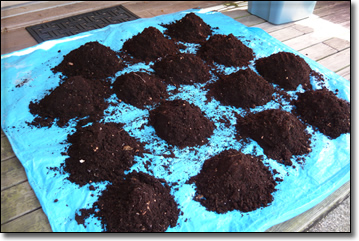 After a measure of time that can be from betwixt one to several months (depending on worm population density) you will notice that most of the original bedding has been converted into a rich, dark earthy fabric. This dark fabric is the worm castings, as well known as vermipost. When most of the original bedding has been consumed it is time to motion your worms into a fresh bin of bedding.
After a measure of time that can be from betwixt one to several months (depending on worm population density) you will notice that most of the original bedding has been converted into a rich, dark earthy fabric. This dark fabric is the worm castings, as well known as vermipost. When most of the original bedding has been consumed it is time to motion your worms into a fresh bin of bedding.
How to Harvest the Castings
So now that it is time to harvest your worm castings you will need a tarp or sheet of plastic large plenty to pour the contents of your bin upon. Cull and expanse with a good amount of indirect light, empty your bin onto the tarp, and so separate the big pile into several smaller piles. Give the worms almost an hour to clamber to the lesser of the each pile (if y'all do this under straight sunlight cut you wait time in one-half). So carefully scoop up the "wormless" vermipost and place its own container. Now take your exposed worms and put them in a freshly bedded bin. It may be a piddling cumbersome at kickoff, just you volition get faster with practice.
The Pile Method
The Sift Method
What is Worm Tea?
Worm tea is a solution made from worm castings and water. Think of what happens when y'all make tea with a tea bag; when you identify a tea bag in water, the properties of the tea leaves leach into the water. The same concord true with worm castings. When you soak worm castings in water the castings are diluted and the benign micronutrients and microorganisms contained within are transferred to the water. This solution gives your plants and an instant boost of energy and nutrition. Non only can you lot feed the roots, you tin utilize a spray bottle and feed the leaves as well. As the worm tea soaks into the soil, the nutrients and beneficial organisms are evenly dispersed into the soil and substrate. Your soil is at present is teeming with molecules that your plants need to sustain healthy and productive life cycles!
Summary
Raising earthworms takes a bit of patience and care. Call back, they are living creatures that require cool, moist bedding and food they tin assimilate. If you follow the tips I've given you, you shouldn't have any problems. The biggest error that beginners tend to make is overfeeding. If you're unsure, give a little less, pay attention, and feed them more when necessary.
Source: https://www.worms4earth.com/index.php?main_page=raising_worms
Posted by: walkertruck1959.blogspot.com


0 Response to "How To Find Red Wiggler Worms In Your Yard"
Post a Comment